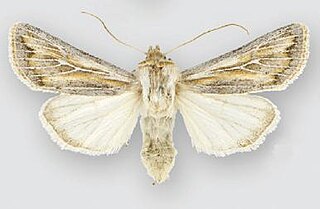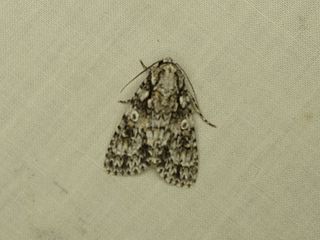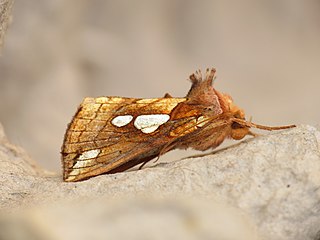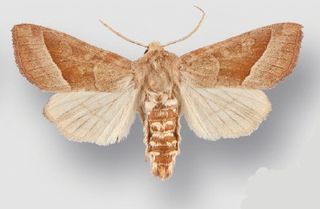
Abronia umbellata is a flowering annual plant which is native to western North America. Other common names include beach sand verbena and purple sand verbena.

Verbena hastata, commonly known as American vervain, blue vervain, simpler's joy, or swamp verbena, is a perennial flowering plant in the vervain family Verbenaceae. It grows throughout the continental United States and in much of southern Canada.

Copablepharon is a genus of moths of the family Noctuidae.

Sympistis greyi is a moth of the family Noctuidae first described by James T. Troubridge and Lars G. Crabo in 1998. It is found in western North America from British Columbia, south through central Washington and central Oregon.

Protogygia comstocki is a moth of the family Noctuidae. It is found in the White Sands National Park, Otero County, New Mexico as well as the Hanford Central and Wahluke dunes in Washington.

Acronicta marmorata, the marble dagger moth, is a moth of the family Noctuidae. It is widespread in the Pacific West of North America, including British Columbia, Oregon and Washington.
Caradrina meralis, the rare sand Quaker, is a moth of the family Noctuidae. The species was first described by Herbert Knowles Morrison in 1875. It is found in North America from New Jersey and New Hampshire, Ontario, Ohio and Wisconsin west across southern Canada to British Columbia, south to California and Arizona.

Plusia putnami, the Lempke's gold spot or Putnam's looper moth, is a species of moth of the family Noctuidae. It is found in the Palearctic realm, from Japan and eastern Siberia to Fennoscandia, Great Britain, and France. In North America, it ranges from Newfoundland and Labrador to central Alaska and the interior of British Columbia, south to Pennsylvania, Washington, north-eastern California, and in the Rocky Mountains to Utah and Colorado.

Raphia frater, the brother moth or simply the brother, is a moth of the family Noctuidae. It is found from Nova Scotia west, across the forested regions of Canada to British Columbia, south to Mississippi in the east. The southern limits in the west are uncertain due to confusion with several closely related species or forms.
Agrotis gravis is a moth of the family Noctuidae. It is found from British Columbia, south to California.

Copablepharon grandis, the pale yellow dune moth, is a moth of the family Noctuidae. The species was first described by Strecker in 1878. It is found in North America from southern Alberta east to south-western Manitoba, the eastern parts of South Dakota, North Dakota and Iowa, west to California and south to southern Arizona, New Mexico and western Texas.

Copablepharon viridisparsa is a moth of the family Noctuidae first described by F. H. Wolley Dod in 1916. It is found from southern California and southern Utah north to southern British Columbia, central Saskatchewan and south-western Manitoba.

Lasionycta brunnea is a moth of the family Noctuidae. It occurs in the Rocky Mountains of Alberta north to Pink Mountain in north-eastern British Columbia, and in the Purcell and Selkirk Mountains in south-western British Columbia and north-eastern Washington.

Psammopolia wyatti is a moth of the family Noctuidae first described by William Barnes and Foster Hendrickson Benjamin in 1926. It occurs in western North America from southern Oregon to the Queen Charlotte Islands of British Columbia. The moth has been included in both 1983 and 2010 MONA indices.

Abronia macrocarpa is a rare species of flowering plant known by the common name largefruit sand verbena. It is endemic to eastern Texas, where its current range is limited to Freestone, Leon, and Robertson counties. It inhabits harsh, open sand dunes on savannas, growing in deep, poor soils. It was first collected in 1968 and described as a new species in 1972. It is a federally listed endangered species of the United States.

Mamestra configurata, the Bertha armyworm, is a moth of the family Noctuidae. It is found in the western part of the North America and Mexico.

Hydraecia obliqua is a moth in the family Noctuidae first described by Leon F. Harvey in 1876. It is found in western North America, east to the Sierra Nevada in California and the crest of the Cascade Range in Oregon and Washington. It occurs continuously on the coast north to south-western British Columbia, with a disjunct northern population at Terrace, British Columbia. The habitat consists of the riparian zone along creeks and rivers of coastal rainforests, as well as oak savanna, mixed hardwood forests and valley grasslands.

Copablepharon canariana is a species of moth in the family Noctuidae. The species was described by James Halliday McDunnough in 1932. It is found in North America.
Noctuini is a tribe of owlet moths in the family Noctuidae. There are at least 520 described species in Noctuini.














